Once Upon a Time, a lore writer for Magic tried to put together a flavor gems article for Throne of Eldraine. He was not a scholar of fairy tales, nor of Arthurian legend, so let's be honest, he used a lot of wikipedia to help write the article. He's not particularly sorry about this.
Enough of the fairy tale framing, and welcome to my flavor gems article. Eldraine was a difficult nut to crack, as the top-down flavor and the new setting means there aren't any lore callbacks for me to point out, and very, very little pre-existing lore to address. Instead, I'm going to largely be doing the work of grouping together the various fairy tales referenced in this set. I should be clear from the start that I'm going to miss references, but hopefully I'll give enough of a grounding here that anything I miss can be easily categorized.
Before we begin, I also want to point out that Eldraine being Arthurian fantasy vs Fairy Tales isn't quite accurate. This set also contains a lot of references to English and Scottish folklore, literature, and in some cases, even pop culture. The Disney analogy will be the most common in most Eldraine discourse, and the mouse's impact on pop culture perception of fairy tales can't be ignored. None of those stories originated with Disney, however, and they're hardly the first to repackage these centuries-old stories.
Before I get any farther, I feel I need to warn the reader here that I'll be discussing aspects of fairy tales that involve topics like rape, cannibalism, and an assortment of other disturbing themes.
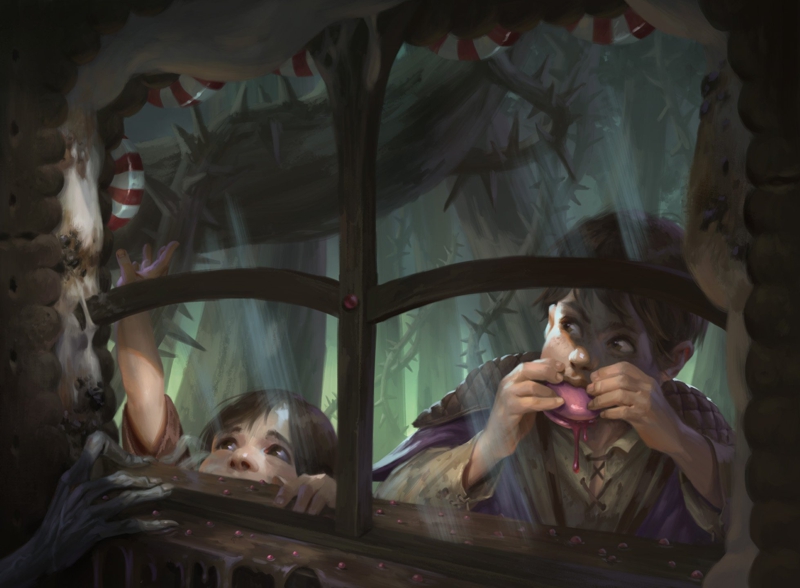
Curious Pair by Daarken
The Story
Throne of Eldraine's story is told through the ebook The Wildered Quest by Kate Elliott. I highly recommend it, and feel free to skip this section if you don't want spoilers. I'm not going into a ton of detail in this article, but the gist is this. The High King Algenus Kenrith is transformed (Kenrith's Transformation) into a stag by the planeswalker Oko (a fairly common fairy tale trope), who wants to incite a war between the realm of human courts and arthurian-esque legend, and the wilds of the fairy tale inspired fae.
Kenrith's children, The Royal Scions go on a quest to find their father, and are given an Unexplained Vision. They track it to find their father, and Garruk is freed from his curse in Return of the Wildspeaker. Oko is defeated, and the Kenrith's live Happily Ever After... at least, sort-of. Will and Rowan's shared spark ignites and they planeswalk away.
Fairy Tale Tropes
Like Once Upon a Time, many cards in Eldraine aren't inspired by a specific fairy tale, but instead the trope space a lot of fairy tales open up. This is especially true with Eldraine's food mechanic, as food (and its relationship with the fae) is a big factor in many fairy tales.
Claim the Firstborn is our Crib Swap of this set. While Crib Swap played on the superstition that some babies have been replaced by changelings, Claim the Firstborn plays in a similar area. In some fairy tales (like Rapunzel), a child is owed to some fae or witch in payment for some slight or debt. It's both a neat flavor reference and deeply disturbing, as all fairy tales should be.
The Charming Prince is so ubiquitous in fairy tales that the fantastic comic Fables combined them all into a single character... with all the drama that would imply.
Beloved Princess is the other major fairy tale reference, and did you catch that she's following a Goldenglow Moth?
Charmed Sleep is a common fairy tale trope, although Sleeping Beauty is the best known example. It also appears a lot in other stories, like Rip Van Winkle.
True Love's Kiss is a fairy tale trope played up in more modern, saccharine versions of fairy tales. Typically as a patch over some of the more... problematic aspects of early fairly tales. For instance, in some early versions of what would become Sleeping Beauty, the Prince rapes and impregnates Sleeping Beauty and it isn't until after she gives birth that she awakens from the curse.
The Spinning Wheel is common to both Sleeping Beauty and Rumplestiltskin. In the former's case, the needle prick is what activates the princess's curse. In the latter, the little fae creature (the eponymous Rumplestiltskin) uses a Spinning Wheel to spin straw into gold.
Many fairy tales involve a dubious merchant, represented by Merchant of the Vale. Whether it's magic beans, a magic lamp, or some other item of curious provenance, the flavor of this Merchant is on point.
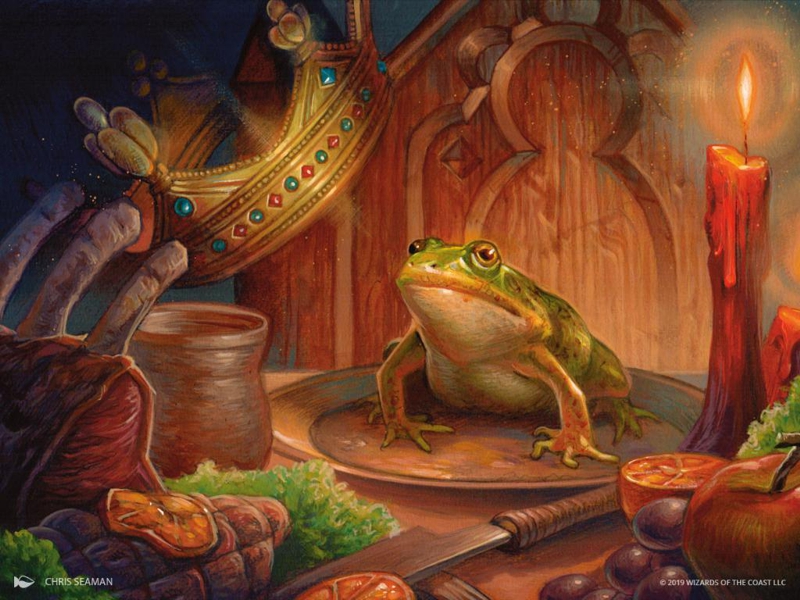
Frogify by Chris Seaman
The cursed nobleman is such a common trope I'm going to put Korvold, Fae-Cursed King here. They didn't turn specific fairy tale references into Legendary Creatures in this set, so Korvold isn't an explicit reference, although he does bear similarity to Fafnir from Norse Mythology.
Grumgully, the Generous is the helpful fae creature trope. There are so many small, helpful creatures that it's hard to say, exactly, which is the strongest reference. In many fairy tales, a traveller who is kind to this creature receives kindness in return, while those who are not often are subject to misfortune.
Arthurian Legend
The Once and Future King is so embedded in the cultural zeitgeist that I think many of the flavorful references in this set to Arthurian legend are hard to miss.
Kenrith, the Returned King is our King Arthur. If I have to explain to you who King Arthur is... well, take a minute and go look it up. Even the title is a cute play on the legends of the Once and Future King. The Royal Scions are a twist on the Mordred trope, and if you're curious what I mean, read The Wildered Quest. Linden, Steadfast Queen is the Guinevere, although without the infidelity.
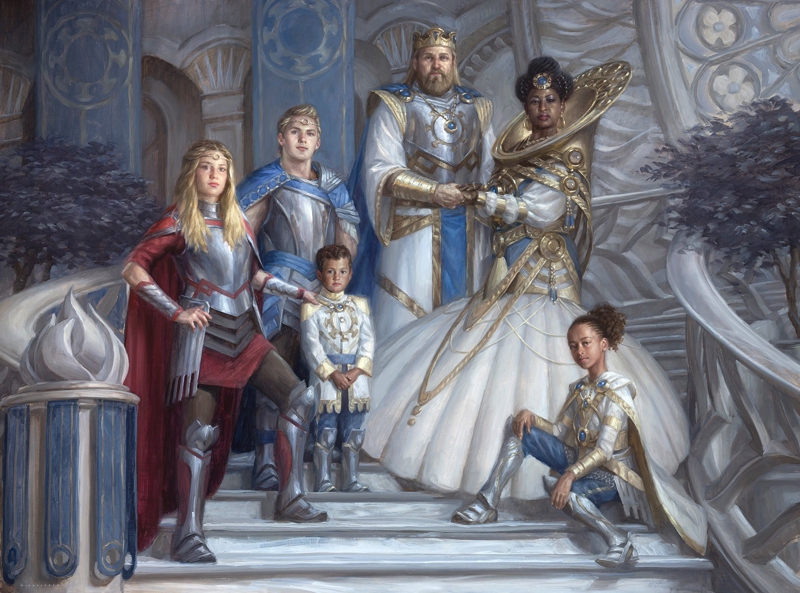
Kenrith Family Portrait by Ryan Pancoast
Emry, Lurker of the Loch is our Lady of the Lake. While exactly what is going on with the Lady of the Lake varies from story to story, the core of the tale is that the Lady provides Excalibur, which eventually ends up in King Arthur's hands. Emry can be seen with a sword in hand, referencing the Lady of the Lake's role in Arthurian legend.
The Questing Beast's name is pretty self explanatory, and while it doesn't show up in every pop culture iteration of the Arthurian legend, it's a creature that's the subject of many quests.
Did you know that the original name for Excalibur in Welch was Caledbwich? Caled translates to 'hard' and bwich translates to... cleave. Embercleave, as a literal sword from the stone, is a sly Excalibur reference in both name and trope space.
The Circle of Loyalty is a stand-in for the Round Table, the imagery and similarities becoming more clear in Silverflame Ritual. Knights like Syr Alin, the Lion's Claw, Syr Elenora, the Discerning, Syr Konrad, the Grim, Syr Carah, the Bold, and Syr Faren, the Hengehammer even have Silverflame Circles on their person!
The Cauldron of Eternity, Forever Young, and Cauldron's Gift are all referencing not just the Holy Grail, although I recommend reading Adrienne's explanation below as to how the Holy Grail myth evolved.
OK so the thing to understand is that there are several different cup/cauldron/dish cycles happening around Europe pre 850 BCE and the subtext of the Arthurian tales is all about Romanization and Christendom entering into Europe by various means.
— Adrienne of Eldraine (@DreamtimeDrinne) September 17, 2019
Gadwick, the Wizened is our obvious Merlin of the set, although one could argue the entirety of Vantress are essentially Merlin analogues. The name is especially clever, here, as the root of Wizard and Wizened is, from middle english, essentially just 'wise'. A Wizard is a wise person, while someone who has been Wizened has become wise (although now it's commonly used to describe someone who is old).
Oathsworn Knight is our Monty Python Black Knight joke... and a pretty fantastic one at that. For those who don't get the joke, the scene is five minutes and well worth your time.
Shakespearean Influences
What 'Fairy Tale' set would be complete without at least a few references to William Shakespeare's A Midsummer Night's Dream? Oko, Thief of Crowns appears to plays the role of Oberon in this set. Oberon is king of the faeries, just as Oko appears to be a fae being of much greater size and power than the faeries of Eldraine. No, he's not married to Titania, Protector of Argoth. If Oko is Oberon, Rankle, Master of Pranks is the obvious Puck of the set, an impish prankster who delights in playing 'jokes' on others.
Fairy Tale Influences
I'm not going to spend a lot of time doing commentary on each individual fairy tale references, as I'm already going very text heavy on this article. Instead, I'll link to the relevant wikipedia article on each fairy tale if you want to know more.
The Golden Goose
The Golden Goose is entangled with Jack and the Beanstalk as well, but has its own story. Both Gilded Goose and Golden Egg references these myths. The eponymous fairy tale features the golden goose as a reward after a young man shares his meager meal with a 'little gray man', not unlike Grumgully, the Generous.
Pied Piper
The Pied Piper of Hamelin is a very famous legend that's been retold endlessly, about a piper with the power over rats... and perhaps children. In most modern versions of the tale, the Piper of the Swarm is a malevolent being, stealing children.
Hansel and Gretel
The tale of Hansel and Gretel is perhaps one of the most iconic fairy tales. Two children lay a Trail of Breadcrumbs and stumble across a Gingerbread Cabin. The Curious Pair are lured in by a Tempting Witch who attempts to bake them into her Witch's Oven to be Baked into a Pie.
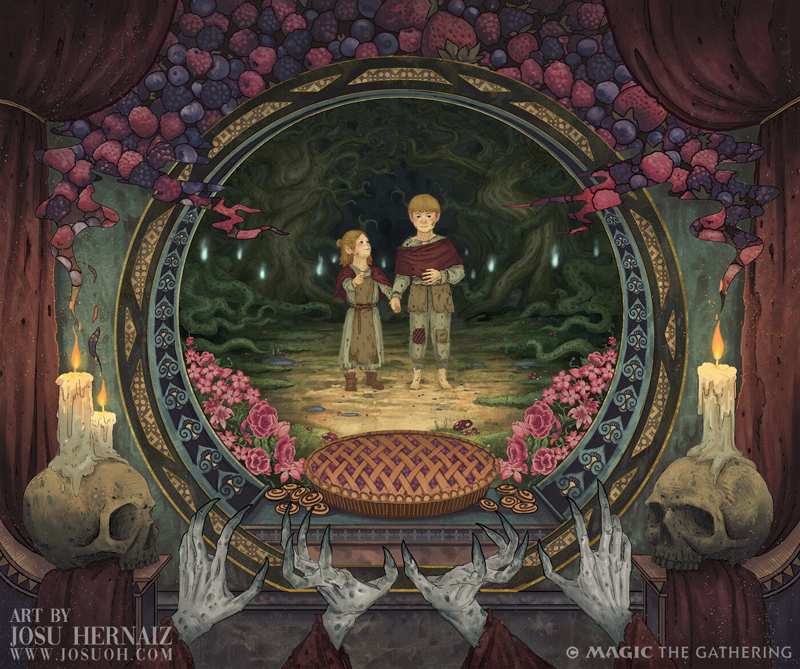
Curious Pair by Josu Hernaiz
In the Magic version of the tale, it appears that they're saved by an Oakhame Ranger.
The Juniper Tree
While many fairy tales involve cannibalism of some sort, the most clear story involving being Baked into a Pie is that of The Juniper Tree. Sharing elements from many other, more well known stories (like Cinderella), this story is often overlooked, as it involves a little boy killed by an abusive stepmother, who bakes him into a pudding and feeds it to her husband. There isn't really a sweet version of this tale to be had.
Snow White
Snow White is very widely known today, thanks to the 1937 film that put Walt Disney Productions on the map. Elements like Taste of Death, involving a poisoned apple, the Seven Dwarves (who work in a Dwarven Mine who take in Snow White. The Magic Mirror and Tempting Witch also factor in to this tale, as do many other flavorful elements in the set, like the Glass Casket used on Snow White after she's poisoned.
The Glass Coffin
A Glass Casket is best known for its part in Snow White's tale, but dates back to its own tale, The Glass Coffin.
Sleeping Beauty/Little Briar Rose
Sleeping Beauty is well known for the Disney version, but as I mention above in the True Love's Kiss section, the story has had horrific implications in past versions. The Spinning Wheel and Charmed Sleep are big elements here. Alela, Artful Provocateur is obviously the evil faerie from this story, best known by her name from the Disney cartoon, Maleficent, although similar evil fae exist all over fairy tales. Rosethorn Acolyte showcases the thorns that spring up all around the castle.
In the best, most perfect Disney reference in the set, regardless of how you feel about Disney's influence on pop culture and perception of fairy tales, is [Righteousness]. This artwork is a knight fighting a black and purple dragon, which is the iconic look of Maleficent in her battle with Prince Philip.
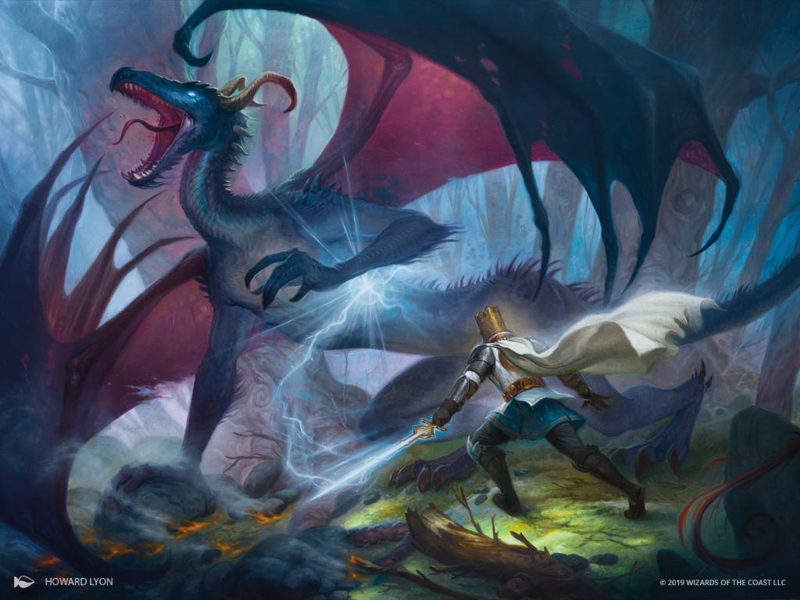
Righteousness by Howard Lyon
The Frog Prince
Frogify is an obvious reference to The Frog Prince, another ubiquitous fairy tale about a princess who falls in love with a frog. The frog transforms into a handsome prince, which happens, depending on the version, through a True Love's Kiss.
Rapunzel
The story of Rapunzel involves all the usual tropes: a witch, a child taken/traded/promised, etc. The most important element here is the long-haired young woman Trapped in the Tower.
The Little Mermaid
The Little Mermaid is a danish fairy tale by Hans Christian Anderson about a mermaid who wishes to become human. Wishful Merfolk plays on that trope by making the merfolk - an undine - desire revenge on the surface world.
Three Billy Goats Gruff
Clackbridge Troll represents both the troll and hilariously the goats of the fairy tale Three Billy Goats Gruff. In the tale, a family of three goats convince the bridge troll to wait and eat the next goat in line, who is fatter and more of a meal. The third goat turns out to be a beefcake who headbutts the troll, and the three goats all make it to the other side in peace.
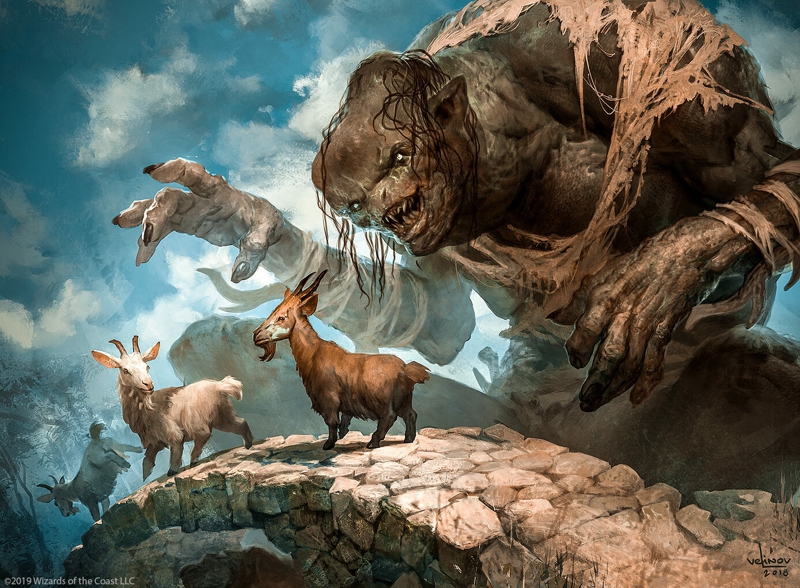
Clackbridge Troll by Svetlin Velinov
The Sorcerer's Apprentice
While the story of The Sorcerer's Apprentice was made famous by the 1940 Disney film Fantasia, it was originally a work by Johann Wolfgang von Goethe from the late 18th century. The gist is that the Overwhelmed Apprentice attempts to get their chores done faster by enchanting the Sorcerer's Broom... who then take on a life of their own.
Magic: the Gathering was, of course, featured in the 2010 adaptation of The Sorcerer's Apprentice, starring Nic Cage. They even made cards!
Goldilocks and the Three Bears
Goldilocks and the Three Bears is the reference Flaxen Intruder is making. Flaxen, by the way, means a pale yellowish-gray.
Little Red Riding Hood
While not specifically references, Rowan, Fearless Sparkmage definitely has 'Red Riding Hood' vibes, while Garruk, Cursed Huntsman fills the Huntsman trope well.
Jack and the Beanstalk
Jack and the Beanstalk is the story about how a young boy, Jack traded his Bartered Cow for a Giant Opportunity of magic beans. Jack plants the beans and ascends to the Beanstalk Giant's home, where he steals treasures (like a Gilded Goose). The giant catches wind, and Jack becomes a Giant Killer when he chops down the beanstalk before the giant can climb all the way down.
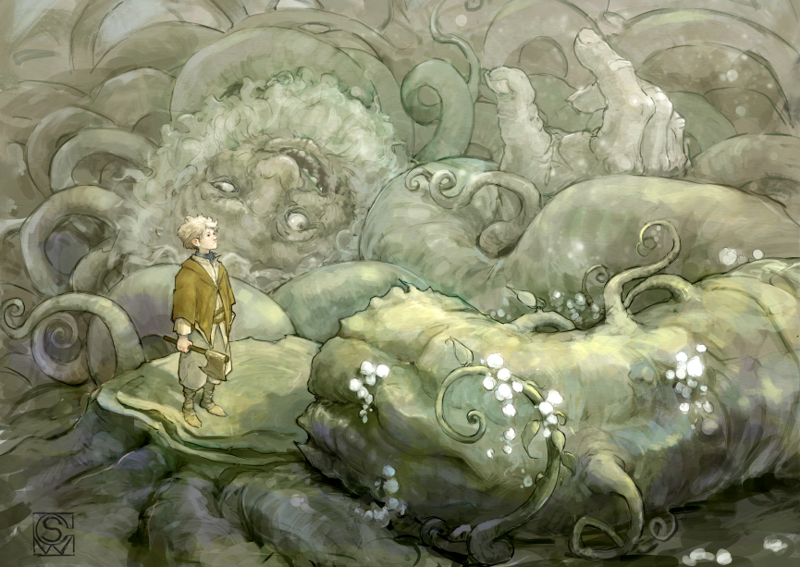
Giant Killer by Shawn Wood
Tall as a Beanstalk is a cute riff on the magic beans. I never thought about what would happen if you ate them.
Cinderella
The story of Cinderella is way more ancient than you might realize, with variants traceable back two millennia. It's no wonder that so many elements of the story appear in so many other stories. Magic's version references the Wicked Guardian who takes custody of the young woman. A Fairy Guidemother takes pity, and creates an Enchanted Carriage for the woman. But she must be back before the Midnight Clock tolls, or the enchanted items will Turn into a Pumpkin or Return to Nature. She wore her Crystal Slippers, but instead of a [Charming Prince] tracking her down, it's instead an elven Wildwood Tracker.
Beauty and the Beast
Beauty and the Beast is the tale of a Lovestruck Beast who falls for the Belle of the Brawl. His entire estate was cursed, but when their return is in sight, there is a Dance of the Manse.
Sorry, this was a struggle to make work.
Pinocchio
Pinocchio is the Italian fable of the children's novel The Adventures of Pinocchio. In it, an Animating Faerie brings life to an Inquisitive Puppet who just wants to be a real boy. Oh, and in the original story Pinocchio is hung from a tree until dead. It was a warning to children, don't be like Pinocchio.
The Three Little Pigs
The Three Little Pigs is a classic story about an allegedly Wicked Wolf who, if you're a pig, wants to Blow Your House Down. The Wolf's Quarry is three little boars in this Magic version. I'm somewhat attached to this story, as my acting debut was playing the Big Bad Wolf himself to rave reviews in my first grade school play.
Bluebeard
Bluebeard is a Malevolent Noble who murders his wives, and the fairy tale centers around a wife trying to avoid the same fate. The flavor text here, I feel, hurts the flavor of the name and the story reference, as it implies that the noble is doing something not malevolent at all... unless he's murdering children to lure in witches.
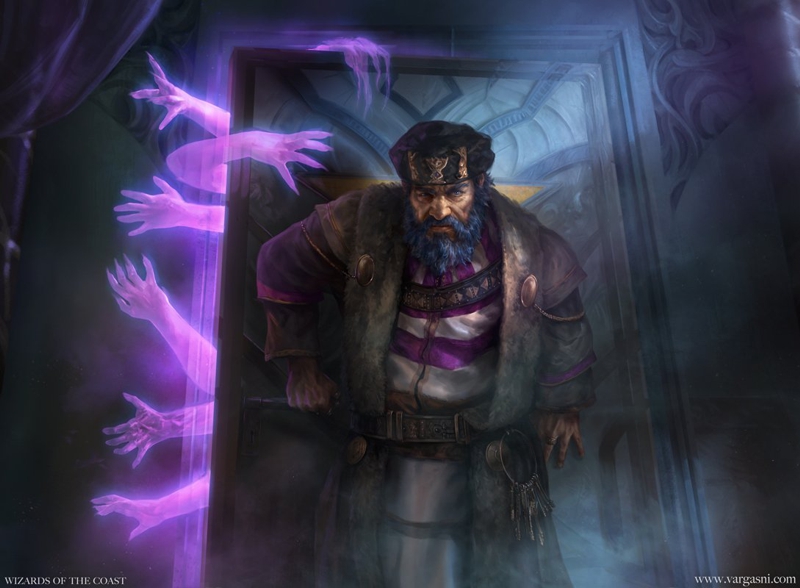
Malevolent Noble by Randy Vargas
The Hobbit
Torbran, Thane of Red Fell feels like one of the most explicit homages to modern fantasy progenitor J.R.R. Tolkien's The Hobbit. The problem with skewing too close to 'classic' dwarves, in this case, is that you get a card that's pretty much just Thorin Oakenshield. I'm not sure what the deal with Torbran is, as he doesn't appear in the story or anywhere else.
Best of the Rest
Not everything in this setting is strictly rooted in Arthurian legend or what we would consider classic Fairy Tales. Some are more rooted in folk tales, a distinction without much of a difference.
Loch Ness Monster - Lochmere Serpent
Robin Hood - Robber of the Rich
... And His Merry Men (specifically Maid Marion, Friar Tuck, and Little John) - Outlaw's Merriment
The Monkey's Paw - Wishclaw Talisman
Howl's Moving Castle - Roving Keep
Thanks it for today, folks! Feel free to let me know what I might have missed in the comments below, there's so much fairy tale lore out there that I feel it'd be impossible to cover it all.



















